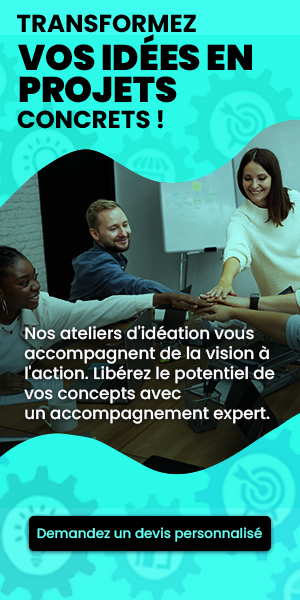Product innovation requires a dynamic and productive creative process, where ideas can spring forth spontaneously and collaboratively. Brainstorming techniques provide fertile ground for generating new and bold ideas. By bringing diverse minds together around a common issue, various methods like mind mapping, reverse brainstorming, or anti-problem can bring forth confusing and enriching concepts. Each of these approaches, by stimulating creativity and encouraging exchange, is a key factor in driving innovation at the heart of product development.
🔥 Nous recommandons Ideamap
Ideamap est l’outil idéal pour un brainstorming ou un projet collaboratif. Grâce son interface facile et à ses fonctions IA, Ideamap booste votre créativité tout en favorisant une meilleure organisation de vos idées pour atteindre vos objectifs.

Brainstorming is an ideation method that promotes creativity and innovation by allowing a group of individuals to generate a maximum number of ideas around a given theme or problem. In the context of product innovation, these ideation sessions are crucial for developing innovative solutions that meet consumer needs while standing out in the market. To achieve this, several brainstorming techniques can be employed to optimize the creative process.
One of the most popular techniques is mind mapping. This method uses a visual representation of ideas where the central concept is linked to secondary ideas and sub-ideas. This allows participants to see the connections between different thoughts and explore the topic in a more dynamic way. By using this approach, teams can uncover hidden insights and develop new product concepts that might otherwise escape a more linear thought process.
Another effective technique is reverse brainstorming. Instead of focusing on generating ideas, this method invites participants to consider how a product might fail or be poorly designed. By identifying potential problems, teams can then turn back to innovation by developing solutions to prevent these failures. This creates a more proactive approach to product development.
Meanwhile, SCAMPER is a method that encourages participants to think about an existing product through different questions: How can we Substitute an element? How can we Combine products to create a new one? What feature can we Adapt or Modify? This technique promotes lateral thinking, which can lead to truly original and innovative ideas.
Another useful tool is the six thinking hats technique, developed by Edward de Bono. This method encourages participants to adopt different points of view: facts, emotions, criticism, optimism, creativity, and organization. Through this approach, each group member can explore the topic from a different angle and contribute to a rich and varied discussion, which can lead to unexpected product innovations.
Brainwriting is also a relevant strategy that helps overcome the hesitations often observed in group discussions. Instead of talking, each participant writes their ideas on paper for a set period, and these ideas are then shared and developed by the group. This method encourages greater participation and gives all ideas an equal chance of being heard.
Finally, case studies can enrich the ideation process. By examining concrete examples of innovative products, teams can analyze what worked or did not work and draw inspiration from these experiences to generate their own ideas and concepts. This approach allows learning from the successes and failures of others while stimulating creativity.
In a constantly evolving world, product innovation is essential to stay competitive. By adopting these brainstorming techniques, companies can transform raw ideas into viable and innovative solutions. The various ideation methods pave the way for creativity, encouraging teams to explore new possibilities and think outside the box.

Frequently Asked Questions about Brainstorming Techniques for Product Innovation
What is brainstorming? Brainstorming is a method of collective creativity where a group generates a maximum number of ideas to solve a problem or develop a product.
What are the main brainstorming techniques? Brainstorming techniques include mind mapping, brainwriting, SWOT analysis, and SCAMPER.
How to organize an effective brainstorming session? To organize an effective session, it is essential to define a clear objective, create an open environment, and follow a structured methodology.
What is the goal of brainstorming in product innovation? The goal is to generate innovative ideas to develop products that meet user needs and stand out in the market.
How to evaluate ideas generated during a brainstorming session? Ideas can be evaluated using criteria such as feasibility, originality, and potential impact on the market.
What is the five whys rule in brainstorming? The five whys rule involves asking the question “Why?” repeatedly to identify the underlying causes of a problem, which can inspire new ideas.
Can brainstorming be used for individual projects? Yes, brainstorming can also be applied to individual projects using techniques like brainwriting or mind mapping.
How to involve the entire team in brainstorming? To involve the whole team, it is important to create a climate of trust, encourage active participation, and establish clear rules for sharing ideas.
What are the mistakes to avoid during a brainstorming session? Among the mistakes to avoid are criticizing ideas, not having enough time to develop them, and lacking facilitation to guide the session.
What is the optimal duration of a brainstorming session? The optimal duration varies, but a session of one to two hours is often sufficient to generate ideas while maintaining energy and engagement from participants.














